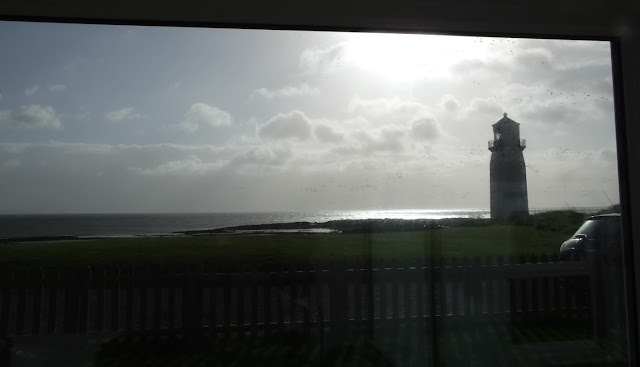The Safari is continuing the tales of south west Scotland today. Somewhat strangely the only two Coots we saw all week despite visiting two quality wetland reserves, one of them repeatedly, was this one on a mural in a hide! And the other? Behind us on the other wall.
A drive over the hills to Newton Stewart had us stopping to enjoy the mountain view and hearing some Crossbills (197) calling from the forest on the far side of the road. A plump looking finchy thing sitting at the top of a Fir tree like a Christmas fairy was probably one of their number but for some weird reason our bins weren't to hand for once.
A lovely river runs through the town with bankside parks and picnic benches where we had our lunch and got mobbed by the Jackdaws for titbits.
A scan through the gulls on a pebbly shoal in the river didn't give us any unusual larids but at the back of the group was our first Goosander (198) of the year. It was to be the only one of the trip.
More walks on the beach at Temporary Base Camp had us looking for shells for Wifey's collection, they have to be just right to pass muster! There were trillions to chose from but only three made the cut!

Visits to the nearest reserve gave us nice views of House Sparrows gleaning Oats from stooks that the wardens had made for them. The crop had failed through being too wet so couldn't be combined and had to be hand scythed the old-fashioned way.
The path through the woodland to one of the hides was littered with golden Beech leaves.
One morning there was a Roe Deer in the undergrowth on the left-hand side so close we could almost have reached out and petted it but we didn't see it until its ears twitched and as soon as it saw us looking at it it bolted off, we totally hadn't seen the even nearer well grown fawn that jumped up and followed mum almost giving us a hearty. The trees hear held the only Great Spotted Woodpecker of the holiday and while walking through it we missed a female Hen Harrier quartering the marshes at the end of the track.
If you go the other way a similarly wooded track leads to the beach, at the start of it there is a bench carved out of a fallen tree trunk well on its way to rotting now where we found this wee little fungus.
A look at the beach proved fruitless with not a bird in sight but there was a pair of
Stonechats where the scratty woodland gave way to the sand dunes.
But the star of the show is the
Barnacle Geese.
Although they were present in prodigious numbers a lone individual was very hard to get pics of. Early morning light and their constant motion made sharp pics difficult - yeah we've always got a feeble excuse!
The noise of the flocks on the ground is phenomenal at close range and the woosh of their wings when they all take off when they spook is like a jet fighter. Enjoy the spectacle on
Autumnwatch next week if you can't get there in person to witness it first hand. Either way you're in for a treat.
We spent an hour with a family in one of the hides showing them the distant ducks through our scope which they enjoyed, otherwise they'd have left bored having not seen anything. We left with them and the young lad at the front of our group spotted a lovely
Brown Hare nibbling the grass at the side of the track only a little way in front of us.
Surprisingly it didn't bolt and allowed the children prolonged views through our bins...brilliant! The main thing they noticed was how much bigger than a Rabbit it was and how black the tips of its ears were...great observations from the youngsters.
Here's some pics from the beach near the cottage.
 |
| Pitted rocks on the beach |
Out on the beach there's a lump of rock sitting on the rocks. It has a name - Cold Magma - a lump of Pluton which is a a remnant of a cooled blob of magma from deep underground which has been driven upwards by tectonic forces over countless millenia. It's from the nearby mountain, Criffel.
 |
| Criffel - with the cloud hat |
The top of the mountain has been eroded by glaciers and that's how the lump got on the beach. There's a couple of much smaller ones too.
 |
| This one's the size of a suitcase rather than a small car |
Lovely place, great wildlife, beautiful scenery and some folk think its OK to chuck their bagged dog turds into the bushes...what disgusting shits! What possesses them, shouldn't be allowed out and shouldn't be allowed a dog either.
Where to next? We could be going a bit batty tomorrow
In the meantime let us know who's doing all the gaggling in your outback.


















































